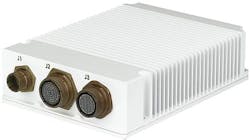Curtiss-Wright chosen to provide rugged Gigabit Ethernet switches for F-16 jet fighter upgrade
Curtiss-Wright has received a contract from Lockheed Martin to supply the Curtiss-Wright COTS-based rugged Gigabit Ethernet switch technology for upcoming F-16 jet fighter upgrade programs for the U.S. Air Force and other nations, Curtiss-Wright officials say.
The first of the upgrade programs is for the Taiwan air force's F-16 fleet. Curtiss-Wright will provide the SMS-652 SwitchBox rugged Gigabit Ethernet switch for Lockheed Martin-built F-16s.
The initial contract is worth about $3 million, and shipments are scheduled to begin in the first half of 2014. The estimated potential value of the contract is about $8 million over the life of the additional upgrade programs, Curtiss-Wright officials say.
The SMS-652 SwitchBox is an open-standards Gigabit Ethernet network switch for rugged military systems. Its compact subsystem eases integrating modern digital networked architectures into military platforms, company officials say.
The SMS-652 SwitchBox reduces design risk and shortens development schedules for bringing network-enabled operations to and legacy airborne, ground combat, and unmanned platforms.
The SMS-652 is a Gigabit Ethernet network switch designed for rugged military airborne, ground vehicle, and space-constrained unmanned vehicle applications. The unit can prepare vehicles for network-enabled operations and is usable in any rugged military application.
The power-efficient switching fabric provides non-blocking wire-speed gigabit performance for 16 ports of 10-, 100-, and 1,000-megabit-per-second Ethernet connections. The SMS-652 weighs less than five pounds and typically consumes 15 Watts of electrical power.
The unit supports IPv4 and IPv6 networks, as well as Port, MAC, and protocol-based VLANs; offers Spanning Tree support (STP, RSTP, MSTP), as well as multicast support (IGMP/MLD snooping. The unit also offers support for jumbo frames to 9 kilobytes, and offers link aggregation and port mirroring.
Other features of the SMS-652 include static routing; energy-efficient Ethernet (EEE) per 802.3az with built-in cable diagnostics; in-band (HTTP/Telnet/SNMP) and out-of-band (RS-232) switch configuration and management; operates in temperatures from -40 to 75 degrees Celsius; runs on 24/28-volt DC power per MIL-STD-1275 for ground applications, MIL-STD-704 for airborne applications, and Def Stan 61-5 for United Kingdom applications. Curtiss-Wright will do the work in its Ottawa facility, and ship the products to Lockheed Martin Aeronautics in Fort Worth, Texas.
For more information contact Curtiss-Wright Controls Defense Solutions online at www.cwcdefense.com, or Lockheed Martin Aeronautics at www.lockheedmartin.com/us/aeronautics.
